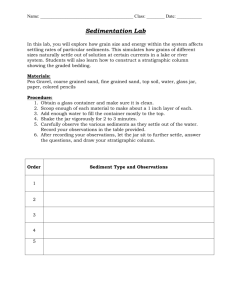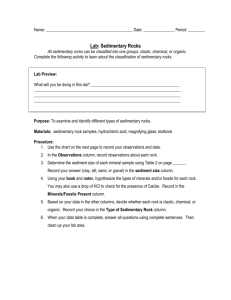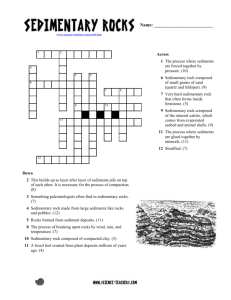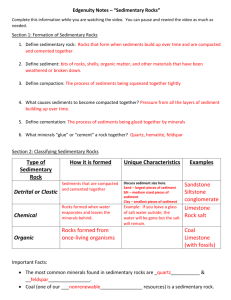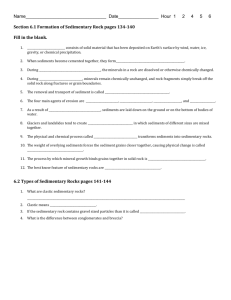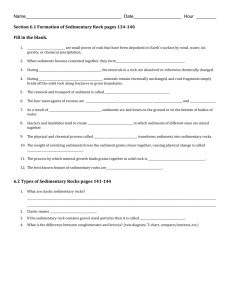Stratigraphy Lab
advertisement
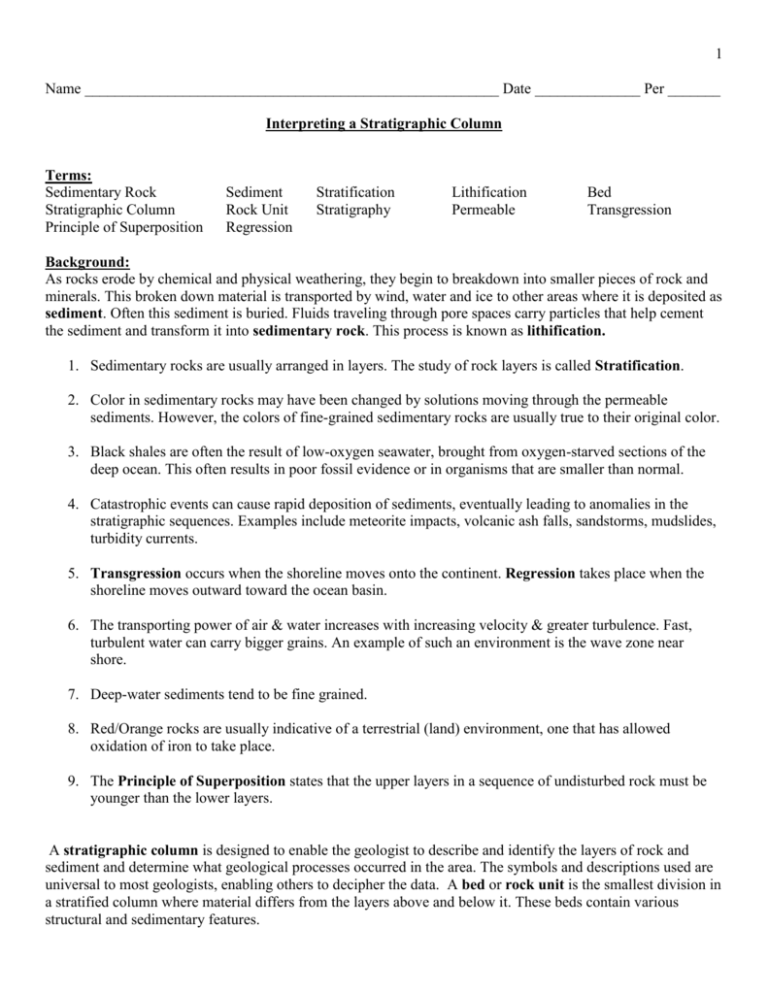
1 Name _______________________________________________________ Date ______________ Per _______ Interpreting a Stratigraphic Column Terms: Sedimentary Rock Stratigraphic Column Principle of Superposition Sediment Rock Unit Regression Stratification Stratigraphy Lithification Permeable Bed Transgression Background: As rocks erode by chemical and physical weathering, they begin to breakdown into smaller pieces of rock and minerals. This broken down material is transported by wind, water and ice to other areas where it is deposited as sediment. Often this sediment is buried. Fluids traveling through pore spaces carry particles that help cement the sediment and transform it into sedimentary rock. This process is known as lithification. 1. Sedimentary rocks are usually arranged in layers. The study of rock layers is called Stratification. 2. Color in sedimentary rocks may have been changed by solutions moving through the permeable sediments. However, the colors of fine-grained sedimentary rocks are usually true to their original color. 3. Black shales are often the result of low-oxygen seawater, brought from oxygen-starved sections of the deep ocean. This often results in poor fossil evidence or in organisms that are smaller than normal. 4. Catastrophic events can cause rapid deposition of sediments, eventually leading to anomalies in the stratigraphic sequences. Examples include meteorite impacts, volcanic ash falls, sandstorms, mudslides, turbidity currents. 5. Transgression occurs when the shoreline moves onto the continent. Regression takes place when the shoreline moves outward toward the ocean basin. 6. The transporting power of air & water increases with increasing velocity & greater turbulence. Fast, turbulent water can carry bigger grains. An example of such an environment is the wave zone near shore. 7. Deep-water sediments tend to be fine grained. 8. Red/Orange rocks are usually indicative of a terrestrial (land) environment, one that has allowed oxidation of iron to take place. 9. The Principle of Superposition states that the upper layers in a sequence of undisturbed rock must be younger than the lower layers. A stratigraphic column is designed to enable the geologist to describe and identify the layers of rock and sediment and determine what geological processes occurred in the area. The symbols and descriptions used are universal to most geologists, enabling others to decipher the data. A bed or rock unit is the smallest division in a stratified column where material differs from the layers above and below it. These beds contain various structural and sedimentary features. 2 Purpose: To illustrate how grain size & sediment color can provide information about relative water depth & possible sea level changes. Directions: Read the background information about the sediments found in stratigraphic columns, & complete the following activities. The units for the column are labeled A-F on the back of each strip. A is the top unit. Exercise 1 1. Make a legend for each kind of sedimentary rock unit (sandpaper type) using colored pencils and label each. 2. Using graph paper, carefully make a scale drawing of the stratigraphic column (the column of sandpapers) you see before you. Label each unit, & show the differences among the sandpapers by using colored pencils. Exercise 1 Questions: (use the background information to guide your thinking) 1. Does the sedimentary sequence illustrate a steadily deepening or shallow water depth? Explain. 2. If the change in depth is due to sea level change, would you call this example a transgression or a regression? Explain. 3. What global event may have occurred to cause the process in question 2? 4. Was the change in sea level or water depth steady or abrupt? What evidence can you give to support your answer? 5. What kind of marine environment do you interpret Unit A to be indicative of? (Unit letters are on the back of the strip) 6. What kind of environment might Unit F reflect? 3 Exercise 2: 1. Using graph paper, carefully make a scale drawing of the stratigraphic column (the long column of sandpapers). Label each unit A-U, & show the differences among the sandpapers by using colored pencils. 2. Using graph paper, plot the changes in water depth. a. Start your graph with the origin in the upper left corner of your paper, so that the most recent unit will be on the top of the graph paper & the oldest unit will be on the bottom. (Y-axis) b. Number the horizontal (X-axis) from 1-8 (evenly spaced from starting from the upper left corner) c. 1 is the most shallow & 8 is the Horizontal Axis Legend: deepest d. The vertical axis will have units A Garnet sandpaper (medium 100) =1 through U positioned in their scaled positions stratigraphically Aluminum oxide sandpaper (extra course 40) =2 e. Each unit will have an X & Y coordinate based o the sandpaper it Aluminum oxide sandpaper (coarse 60) =3 represents f. Plot your points so that the point Aluminum oxide sandpaper (medium 100) =4 matches up with the lowest point of that bed before going on to the Aluminum oxide sandpaper (fine 150) =5 next bed layer Aluminum oxide sandpaper (very fine 220) =6 When you have plotted all the points connect them with a line. The drawing you have made will illustrate more clearly the changes that have taken place through time Silicon Carbide sandpaper (ultra fine 600) =7 Emery cloth sandpaper (fine) =8 Exercise 2 Questions: 1. How many deepening cycles were there, & where do they occur? [Use the rock unit (bed) letters] 2. What do you think happened to Unit J? 3. Are any terrestrial units represented in the column? Any near shore? What evidence can you give to support your answer? 4. In spite of the changes & repetitions, would you consider this sequence, in the long term, to be transgressive or regressive? Explain. 5. What fossils, if any would you expect to find in the beds of Units R through U?



